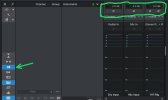CaptOblivious
Blues Junior
1. JP's interface for guitar input is exceptionally low, which requires that the backing track be turned down on the backing track channel fader so they can be level matched for the output.
While not the exact topic, I have questions on guitar input level. I am exclusive all digital using IK Multimedia Amplitude 5.0. My A/I is a IK Stomp I/O. It has preamp gain control with a max of +27dB of gain. The AT5 app has an input fader control that maxes out at 15 dB. My question is which is the preferred or better/worse method to control guitar input? Should I max out each one to just below clipping, or something else? This and figuring out a few days too late that intonation on the guitar I was using was seriously off will help going forward. Note to self after changing pickups check intonation, duh.
Edited by @PapaRaptor: This post is forked from:
Mellow Jam E major
Here is a nice slow, non bluesy jam in E major. I took the first 1:58. Mellow jam E major - TZ
bluesguitarunleashed.com
Last edited by a moderator:

